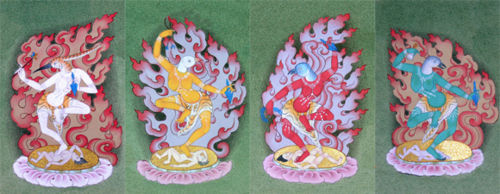Fifty-eight wrathful deities
The fifty-eight wrathful deities belong to the mandala of the Hundred Peaceful and Wrathful Deities, and feature in several practices and cycles of teachings, most notably the Tibetan Book of the Dead and the Guhyagarbha Tantra. They are:
1-10) The Five Wrathful Herukas and their Five Consorts
The five wrathful herukas and their five consorts—the wrathful aspect of the buddhas of the five families and of the five female buddhas—are:
- Buddhaheruka and his consort Buddhakrodhishvari;
- Vajraheruka and his consort Vajrarodhishvari;
- Ratnaheruka and his consort Ratnarodhishvari;
- Padmaheruka and his consort Padmakrodhishvari and
- Karmaheruka and his consort Karmakrodhishvari.
11-18) The Eight Wrathful Females
The eight wrathful females or eight gaurima (Skt. gaurī; Tib. གཽ་རི་མ་བརྒྱད་, gaurima gyé, Wyl. gau ri ma brgyad) are:
- Gauri (Skt. Gaurī;[1] Wyl. ko'u ri), The White Lady (dkar mo)[2]
- Pukkasi (Skt. Pukkasī; Wyl. pus ka si), The Fragrant Lady (spos mo)
- Chauri (Skt. Caurī; Wyl. tso'u ri), The Thief Lady (chom rkun ma)
- Ghasmari (Skt. Ghasmarī; Wyl. kas ma ri), The Voracious Lady (sme sha can)
- Pramoha (Skt. Pramohā; Wyl. pra mo), The Bewildered Lady (rab tu rmongs ma)
- Chandali (Skt. Caṇḍālī; Wyl. tsan dha li), The Fierce Lady (gtum mo)
- Vetali (Skt. Vetālī; Wyl. be'e ta li), The Undead Lady (ro langs ma)
- Shmashani (Skt. Śmaśānī; Wyl. sme sha ni), The Charnel Ground Lady (dur khrod ma)
19-26) The Eight Tramen
The eight tramen (Skt. piśacī; Tib. ཕྲ་མེན་བརྒྱད་, tramen gyé, Wyl. phra men brgyad), or eight singhama (སིམ་ཧ་བརྒྱད་, sim ha brgyad) are animal-headed deities (tramen literally means 'hybrid'). They are:
- Simhamukha (Skt. Siṃhamukhā)[3], The Lion-Faced Lady (seng gdong ma)
- Vyaghrimukha (Skt. Vyāghramukhā) The Tiger-Faced Lady (stag gdong ma)
- Srigalamukha (Skt. Śṛgālamukhā) The Jackal-Faced Lady (wa gdong ma)
- Shvanamukha (Skt. Śvanamukhā) The Wolf-Faced Lady (spyang ki)
- Gridhamukha (Skt. Gṛdhramukhā) The Vulture-Faced Lady (bya rgod)
- Kangkamukha (Skt. Kaṅkamukhā; Wyl. kang ka mu kha) The Heron-Faced Lady (dur bya)
- Kakamukha (Skt. Kākamukhā) The Crow-Faced Lady (bya rog)
- Ulumukha (Skt. Ulūkamukhā) The Owl-Faced Lady ( 'ug pa'i gdong can ma)
27-30) The Four Female Gatekeepers
The four female gatekeepers (Tib. སྒོ་མ་བཞི་, go ma shyi, Wyl. sgo ma bzhi) are:
- Ankusha (Skt. Aṅkuśā; Wyl. lcags kyu ma or rta gdong ma) also called 'Horse Face' or 'Iron Hook', guarding the east gate and in union with Vijaya (or Achala?)
- Pasha (Skt. Pāśā; Wyl. zhags pa ma or phag gdong ma) also called 'Sow Face' or 'the Noose', guarding the south gate and in union with Yamantaka
- Shrinkhala (Skt. Śṛṅkhalā; Wyl. lcags sgrog ma or seng gdong ma) also called 'Lion Face' or 'Iron Chain', guarding the west gate and in union with Hayagriva
- Ghanta (Skt. Ghaṇtā; Wyl. dril bu ma or spyang gdong ma) also called 'Wolf Face' or 'the Bell', guarding the north gate and in union with Amritakundali.
31-58) The Twenty-eight Ishvaris
The twenty-eight ishvaris (Skt. īśvarī; Tib. དབང་ཕྱུག་མ་ཉེར་བརྒྱད་, wangchukma nyer gyé, Wyl. dbang phyug ma nyer brgyad)
The twenty-eight ishvaris are composed of four groups of six yoginis corresponding to the four activities, and of the four female outer-gate keepers:
1. The six yoginis corresponding to the activity of pacifying:

- Rakshasi (white)
- Brahmi
- Mahadevi
- Lobha
- Kumari
- Indrani
2. The six yoginis corresponding to the activity of increasing:

- Vajra
- Shanti
- Amrita
- Chandra
- Danda
- Rakshasi (dark yellow)
3. The six yoginis corresponding to the activity of magnetizing:

- Bhakshini
- Rati
- Mahabala
- Rakshasi (pale red)
- Kama
- Vasuraksha
4. The six yoginis corresponding to the activity of subjugating:

- Vayudevi
- Nari
- Varahi
- Nanda
- Mahahastini
- Varunadevi
5. The last group is composed of the four female outer-gate keepers.

59-60) Chemchok Heruka and his Consort
The fifty-eight wrathful deities become sixty when you add Chemchok Heruka (Wyl. che mchog heruka) and his consort Krodhishvari, who are the wrathful aspects of Samantabhadra and Samantabhadri.
Notes
- ↑ Unless marked with an asterisk, the Sanskrit has been attested in various tantras translated for 84.000 or other sources.
- ↑ The translations into Tibetan are taken from Longchenpa's Dispelling Darkness in the Ten Directions
- ↑ The Sanskrit words of all eight goddesses are only attested in Monier Williams
Further Reading
- Thinley Norbu, The Small Golden Key (Shambhala Publications, 1999), pages 81-88.